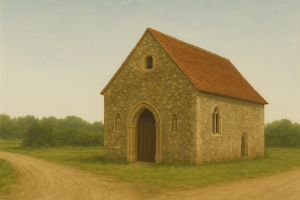
Although it is now known as the Old Bluecoat School, the building was originally the Chapel of the Borough of Thatcham. The earliest known record is a Licence granted by the Bishop of Salisbury in 1304 at the request of Sir Richard de Fokerham to hold Chantry Masses in “the chapel which is said to have been already erected in the east part of the town”, suggesting that the building is older than 1304. The chapel stands on the eastern boundary of the newly created medieval Borough of Thatcham.
It is not known why the chapel was built, however the position of the building by the medieval highway between London and Bristol strongly suggests that it was a freestanding Wayside Chapel for travellers to give thanks for their safety and pray for their onward journey. The travellers would leave donations, and the Bishop’s Licence required the profits to be shared with the mother church of Thatcham. Neither the mother church, nor Reading Abbey, appears to have had a role in the running of the Chapel.
The de Fokerhams were an influential Worcestershire family and lords of the manor of Warley Wighorn near Halesowen. Sir Richard was recorded as living at Colthorp manor in 1272 and 1307, possibly to look after the family’s estates at Hungerford. He was MP for Berkshire between 1305 and 1311, but appears to have returned to Worcestershire after 1312 when he became lord of the manor of Warley Wighorn.
The Chapel is said to have been dedicated to St Thomas the Martyr (Thomas Becket). The only reference is in a draft deed for a property transaction in Chapel Street in 1446. A Proclamation by Henry VIII in 1538 decreed that all references to Thomas Becket shall be obliterated, so the Chapel could not have been dedicated to St Thomas after that date.
The chantries were abolished by Edward VI in 1548 by seizure of their assets that paid for the chantry priests. No record has been found of the fate of the Thatcham chantry in the records of the commissioners of Edward VI. There could be several explanations for the lack of a record, but the belief that the chapel building was closed is unproven. The chapel may not have had any chantry assets to seize so was ignored.
Some of the features of the ecclesiastical building can be traced at the present time, as for example its situation, its bearings due east and west at the entrance to the town, the two canopied niches – one on either side if the west door – the bell-turret at the west end, the priest’s door on the south side, and the piscina.
Long after its [presumed] abolition this building continued to be known as the Chapel of the Borough of Thatcham, and in the Court Roll of the Borough for the year 1691…..it is expressly called the Chapel of this Borough, which suggests that it might have still been in use.